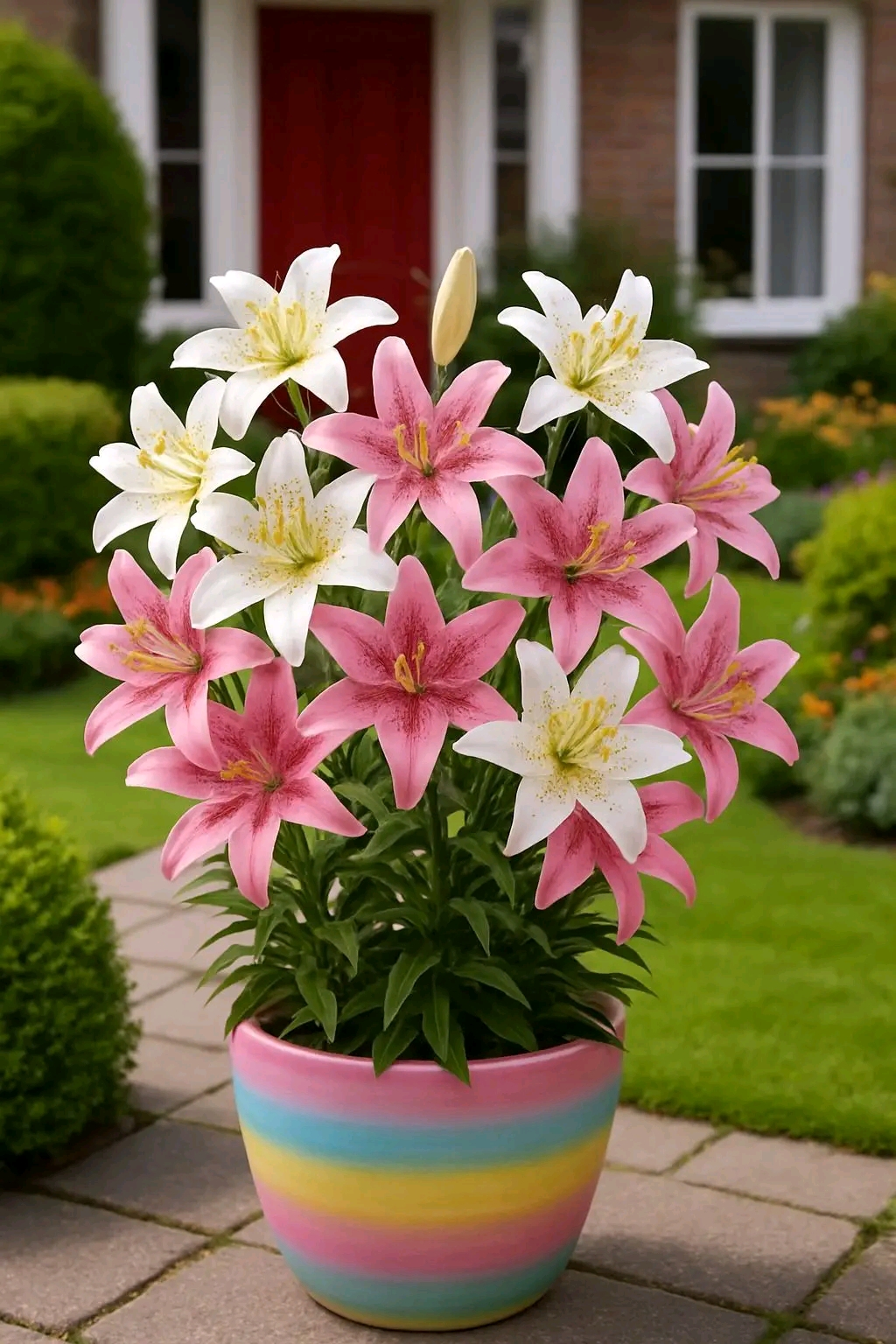1. Understanding Asiatic Lilies
Asiatic lilies (Lilium hybrids) are among the earliest lilies to bloom in summer, usually in late spring to early summer, depending on climate. They are hardy perennials (USDA zones 3–8) that produce upright stems topped with clusters of star-shaped blooms.
Key traits:
Bloom time: Late spring to midsummer.
Height: 1–4 feet tall.
Flower colors: Wide range, often in solids, bicolors, or speckles.
Fragrance: Generally unscented (unlike Oriental lilies).
2. Choosing Your Planting Method
You can grow Asiatic lilies from:
Bulbs (most common — planted in fall or early spring).
Pre-potted plants (like your photo, available from nurseries in spring).
3. When to Plant
Fall planting: Best for strong root development and earlier blooms next year.
Spring planting: Works well for containers and climates with harsh winters.
Plant as soon as the soil is workable (spring) or before the ground freezes (fall).
4. Location Requirements
Sunlight
Full sun (6–8 hours daily) is ideal for maximum blooms.
In hot climates, afternoon shade can prevent scorched petals.
Wind Protection
Choose a spot with gentle airflow but not exposed to strong winds, as tall stems can snap.
5. Soil Preparation
Lilies need well-draining soil to avoid bulb rot.
Soil mix for garden planting:
Loamy soil enriched with compost or aged manure.
Slightly acidic to neutral pH (6.0–7.0).
For containers:
Use a high-quality potting mix with added perlite or coarse sand.
Ensure pots have multiple drainage holes.
6. Planting Asiatic Lily Bulbs in the Ground
Depth & Spacing:
Plant bulbs 6–8 inches deep (measured from the base to soil level).
Space bulbs 8–12 inches apart.
Orientation:
Place bulbs with pointed tips upward and basal roots downward.
Watering after planting:
Water lightly to settle the soil, but avoid waterlogging.
7. Planting Asiatic Lilies in Pots
Growing in containers, like your photo, is perfect for patios and porches.
Steps:
Choose a pot at least 10–12 inches deep for dwarf types and 14–16 inches for taller types.
Fill with a free-draining potting mix enriched with slow-release fertilizer.
Plant bulbs 4–6 inches deep and about 3 inches apart.
Water lightly after planting.
8. Watering Schedule
During active growth: Keep soil evenly moist but never soggy.
Container lilies: Check daily in warm weather — containers dry faster.
Avoid wetting foliage when watering to prevent fungal issues.
9. Fertilizing for Strong Growth
Lilies are moderate feeders.
Fertilizer plan:
At planting: Mix in a slow-release bulb fertilizer (e.g., 5-10-10).
During growth: Feed every 3–4 weeks with a balanced fertilizer (e.g., 10-10-10 or liquid seaweed).
Stop feeding after blooms fade to allow bulbs to rest.
10. Supporting the Stems
Asiatic lilies have sturdy stems, but taller varieties or windy areas may require support:
Use single stakes or small bamboo canes.
Tie loosely with soft ties or twine to avoid damage.
11. Deadheading & Pruning
Deadhead: Remove spent flowers promptly to prevent seed formation, which drains bulb energy.
Leave foliage: Allow leaves to remain until they turn yellow and wither naturally — they feed the bulb for next year.
12. Pests and Diseases
Common pests:
Lily beetles: Bright red beetles; handpick or use neem oil.
Aphids: Can spread viruses; control with insecticidal soap.
Diseases:
Botrytis blight: Causes brown spots; prevent by spacing plants for airflow.
Bulb rot: Avoid overwatering and plant in well-drained soil.
13. Winter Care
In the ground (zones 3–8): Mulch after the first frost to protect bulbs.
In containers: Move pots to a frost-free but cool location (garage, shed) and water sparingly during dormancy.
14. Dividing & Replanting
Lilies can stay in the same spot for several years but may get crowded.
Dig and divide bulbs every 3–4 years in fall after foliage dies back.
Replant immediately or store in a cool, dry place until spring.
15. Design & Companion Planting
Asiatic lilies mix beautifully with:
Salvia, coneflowers, and daylilies for summer color succession.
Low-growing annuals like alyssum or petunias to hide the bare base of stems.
16. Special Tips for the Pink-and-White Variety in Your Photo
- Choose a sunny but slightly sheltered location to keep petals vibrant.
- Use a colorful container (like your pastel-striped pot) to enhance the blooms’ bicolor charm.
- Rotate the pot weekly so all sides receive equal sunlight, encouraging upright stems.
17. Annual Care Calendar for Asiatic Lilies
January–February
- Check stored bulbs for rot or shriveling; lightly mist if dry.
March–April
- Plant bulbs outdoors once frost danger passes.
- Start container lilies in pots indoors if you want earlier blooms.
May–June
- Fertilize regularly.
- Stake tall varieties.
June–July
- Enjoy blooms; deadhead spent flowers.
August
- Reduce watering as plants yellow.
September–October
- Cut back dead stems.
- Divide and replant bulbs if needed.
November–December
- Apply mulch outdoors or store pots indoors in cold climates.
🌟 Final Thoughts
Asiatic lilies are one of the easiest bulbs to grow, rewarding you with elegant, upright flowers in a rainbow of colors — including the stunning pink-and-white mix in your pot. By giving them full sun, well-drained soil, consistent moisture, and seasonal feeding, you’ll enjoy blooms year after year.
Whether in a garden bed or a cheerful pastel pot like yours, they bring a burst of joy to any setting — and unlike fussier lilies, they don’t demand constant care. Plant them once, follow this guide, and your lilies will reward you with spectacular displays for many summers to come.
More Articles You Might Like
-
Texas Toast Sloppy Joes: The Crunchy, Cheesy Upgrade You Didn’t Know You Needed
There’s something timeless about sloppy joes. For generations, this saucy, savory, and slightly sweet ground beef sandwich has been a go-to comfort food in American kitchens. It’s quick, filling, and family-friendly—perfect for busy weeknights. But what if we told you there’s a way to take this classic dish up a notch? Enter the Texas Toast…
-
Classic Pig Pickin’ Cake
When it comes to Southern desserts, few sweets shine as brightly as the Classic Pig Pickin’ Cake. This nostalgic cake, sometimes called a “Mandarin Orange Cake,” has roots deep in Southern tradition. It gets its playful name from its frequent appearance at pig pickin’s—Southern-style barbecue gatherings where communities come together to enjoy slow-cooked pork, sides,…
-
Lemon Garlic Butter Chicken with Creamy Parmesan Pasta
There’s something irresistible about the combination of tender, golden-browned chicken paired with a creamy pasta coated in Parmesan cheese. Add the brightness of lemon, the depth of garlic, and the richness of butter, and you have a recipe that feels indulgent yet approachable enough for a weeknight dinner. Lemon Garlic Butter Chicken with Creamy Parmesan…



